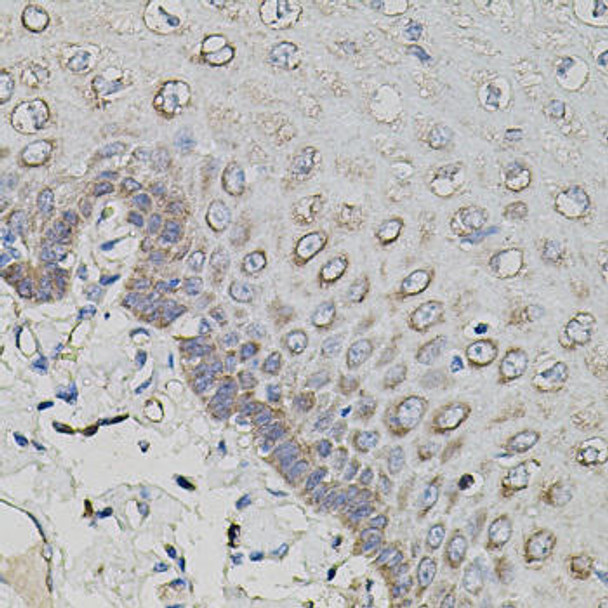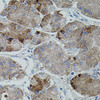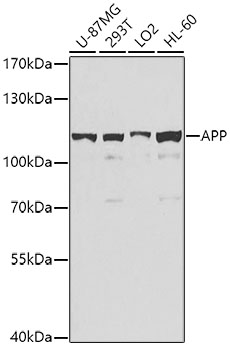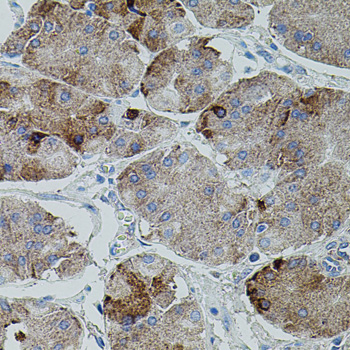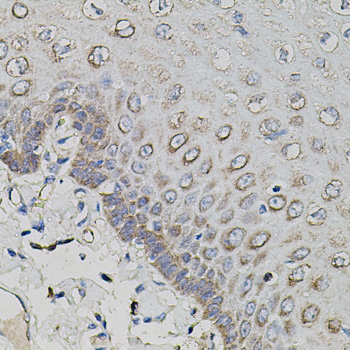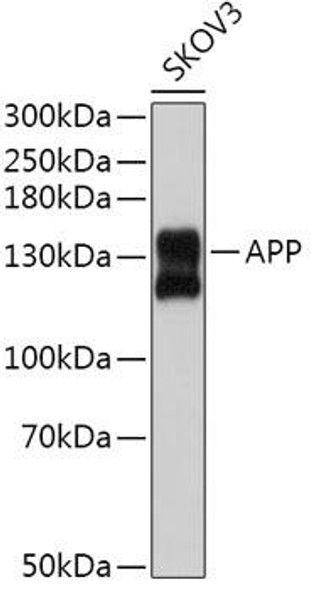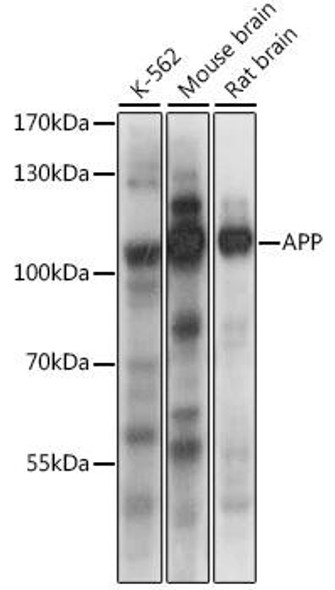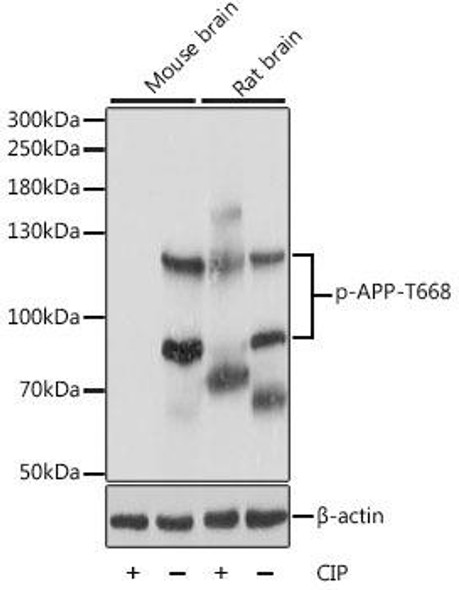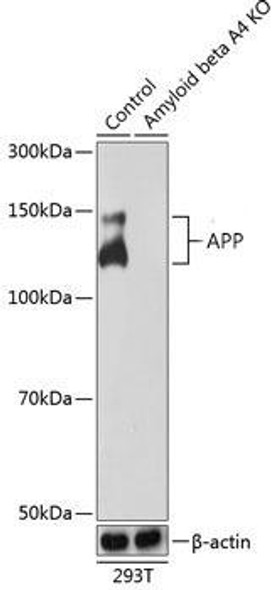Anti-APP Antibody (CAB0206)
- SKU:
- CAB0206
- Product Type:
- Antibody
- Reactivity:
- Human
- Host Species:
- Rabbit
- Isotype:
- IgG
- Antibody Type:
- Polyclonal Antibody
- Research Area:
- Cell Death
Description
Anti-APP Antibody (CAB0206)
The APP Polyclonal Antibody (CAB0206) is a valuable tool for researchers studying amyloid precursor protein (APP), a key player in the pathogenesis of Alzheimer's disease. This antibody, generated in rabbits, is highly specific to human samples and is validated for use in various applications such as Western blotting.APP is a transmembrane protein that is processed to form amyloid-beta peptides, which accumulate in the brains of Alzheimer's patients and lead to neurodegeneration. By targeting APP with this antibody, researchers can detect and analyze its levels in different cell types, providing insights into the mechanisms underlying Alzheimer's disease progression.
The APP Polyclonal Antibody is essential for studying APP biology and its role in neurodegenerative disorders. Its high specificity and sensitivity make it a reliable tool for researchers aiming to unravel the molecular pathways involved in Alzheimer's disease development and progression. This antibody is a valuable asset in the quest for effective therapeutic strategies for this devastating condition.
| Antibody Name: | Anti-APP Antibody |
| Antibody SKU: | CAB0206 |
| Antibody Size: | 20uL, 50uL, 100uL |
| Application: | WB IHC |
| Reactivity: | Human |
| Host Species: | Rabbit |
| Immunogen: | A synthetic peptide corresponding to a sequence within amino acids 190-290 of human APP (NP_000475.1). |
| Application: | WB IHC |
| Recommended Dilution: | WB 1:500 - 1:2000 IHC 1:50 - 1:200 |
| Reactivity: | Human |
| Positive Samples: | U-87MG, 293T, LO2, HL-60 |
| Immunogen: | A synthetic peptide corresponding to a sequence within amino acids 190-290 of human APP (NP_000475.1). |
| Purification Method: | Affinity purification |
| Storage Buffer: | Store at -20'C. Avoid freeze / thaw cycles. Buffer: PBS with 0.02% sodium azide, 50% glycerol, pH7.3. |
| Isotype: | IgG |
| Sequence: | AEES DNVD SADA EEDD SDVW WGGA DTDY ADGS EDKV VEVA EEEE VAEV EEEE ADDD EDDE DGDE VEEE AEEP YEEA TERT TSIA TTTT TTTE SVEE VVRE V |
| Gene ID: | 351 |
| Uniprot: | P05067 |
| Cellular Location: | Membrane, Single-pass type I membrane protein, clathrin-coated pit |
| Calculated MW: | 34kDa/72-86kDa |
| Observed MW: | 110kDa |
| Synonyms: | AAA, ABETA, ABPP, AD1, APPI, CTFgamma, CVAP, PN-II, PN2, Amyloid beta A4, APP, ABeta42, preA4 |
| Background: | This gene encodes a cell surface receptor and transmembrane precursor protein that is cleaved by secretases to form a number of peptides. Some of these peptides are secreted and can bind to the acetyltransferase complex APBB1/TIP60 to promote transcriptional activation, while others form the protein basis of the amyloid plaques found in the brains of patients with Alzheimer disease. In addition, two of the peptides are antimicrobial peptides, having been shown to have bacteriocidal and antifungal activities. Mutations in this gene have been implicated in autosomal dominant Alzheimer disease and cerebroarterial amyloidosis (cerebral amyloid angiopathy). Multiple transcript variants encoding several different isoforms have been found for this gene. |
| UniProt Protein Function: | APP: a cell surface receptor that influences neurite growth, neuronal adhesion and axonogenesis. Cleaved by secretases to form a number of peptides, some of which bind to the acetyltransferase complex Fe65/TIP60 to promote transcriptional activation. The Abeta peptide is released from the cell, its extracellular deposition and accumulation form the main components of amyloid plaques in Alzheimer's disease. Mutations in this gene have been implicated in autosomal dominant Alzheimer disease and cerebroarterial amyloidosis. Can promote transcription activation through binding to Fe65-Tip60 and inhibits Notch signaling through interaction with Numb. Couples to apoptosis-inducing pathways such as those mediated by G(O) and JIP. Inhibits G(O) alpha ATPase activity. Acts as a kinesin I membrane receptor, mediating the axonal transport of beta-secretase and presenilin 1. Involved in copper homeostasis/oxidative stress through copper ion reduction. In vitro, copper-metallated APP induces neuronal death directly or is potentiated through Cu(2+)-mediated low-density lipoprotein oxidation. Can regulate neurite outgrowth through binding to components of the extracellular matrix such as heparin and collagen I and IV. Induces a RAGE-dependent pathway that activates p38 MAPK, resulting in internalization of amyloid-beta peptide and leading to mitochondrial dysfunction in cultured cortical neurons. Provides Cu(2+) ions for GPC1 which are required for release of nitric oxide (NO) and subsequent degradation of the heparan sulfate chains on GPC1. Binds, via its C-terminus, to the PID domain of several cytoplasmic proteins, including APBB family members, the APBA family, JIP1, SHC1 and, NUMB and DAB1. Binding to DAB1 inhibits its serine phosphorylation. Associates with microtubules in the presence of ATP and in a kinesin-dependent manner. Amyloid beta-42 binds nAChRA7 in hippocampal neurons. Beta-amyloid associates with HADH2. Soluble APP binds, via its N-terminal head, to FBLN1. Expressed in all fetal tissues examined with highest levels in brain, kidney, heart and spleen. Weak expression in liver. In adult brain, highest expression found in the frontal lobe of the cortex and in the anterior perisylvian cortex- opercular gyri. Moderate expression in the cerebellar cortex, the posterior perisylvian cortex-opercular gyri and the temporal associated cortex. Weak expression found in the striate, extra- striate and motor cortices. Expressed in cerebrospinal fluid, and plasma. 10 isoforms of the human protein are produced by alternative splicing. Isoform APP695 is the predominant form in neuronal tissue, isoform APP751 and isoform APP770 are widely expressed in non- neuronal cells. Isoform APP751 is the most abundant form in T-lymphocytes. Appican is expressed in astrocytes. The splice isoforms that contain the BPTI domain possess protease inhibitor activity. Belongs to the APP family. |
| UniProt Protein Details: | Protein type:Receptor, misc.; Membrane protein, integral; Cell surface; Transcription factor; Apoptosis Chromosomal Location of Human Ortholog: 21q21.3 Cellular Component: Golgi apparatus; extracellular space; cell surface; integral to plasma membrane; integral to membrane; coated pit; intercellular junction; cytosol; ER to Golgi transport vesicle; lipid raft; ciliary rootlet; perinuclear region of cytoplasm; nuclear envelope lumen; cytoplasm; synapse; dendritic shaft; neuromuscular junction; endosome; receptor complex; intracellular membrane-bound organelle; extracellular region; dendritic spine; axon; apical part of cell; plasma membrane; spindle midzone Molecular Function:serine-type endopeptidase inhibitor activity; heparin binding; identical protein binding; protein binding; protease activator activity; enzyme binding; DNA binding; transition metal ion binding; PTB domain binding; acetylcholine receptor binding; receptor binding Biological Process: extracellular matrix organization and biogenesis; adult locomotory behavior; mRNA polyadenylation; locomotory behavior; positive regulation of mitotic cell cycle; protein amino acid phosphorylation; regulation of translation; platelet degranulation; synaptic growth at neuromuscular junction; forebrain development; dendrite development; visual learning; collateral sprouting in the absence of injury; neuromuscular process controlling balance; cell adhesion; neurite development; cholesterol metabolic process; platelet activation; Notch signaling pathway; cellular copper ion homeostasis; regulation of epidermal growth factor receptor activity; axon cargo transport; mating behavior; regulation of multicellular organism growth; endocytosis; axon midline choice point recognition; smooth endoplasmic reticulum calcium ion homeostasis; negative regulation of neuron differentiation; neuron apoptosis; axonogenesis; suckling behavior; ionotropic glutamate receptor signaling pathway; regulation of synapse structure and activity; regulation of protein binding; innate immune response; positive regulation of transcription from RNA polymerase II promoter; response to oxidative stress; blood coagulation; neuron remodeling Disease: Alzheimer Disease |
| NCBI Summary: | This gene encodes a cell surface receptor and transmembrane precursor protein that is cleaved by secretases to form a number of peptides. Some of these peptides are secreted and can bind to the acetyltransferase complex APBB1/TIP60 to promote transcriptional activation, while others form the protein basis of the amyloid plaques found in the brains of patients with Alzheimer disease. In addition, two of the peptides are antimicrobial peptides, having been shown to have bacteriocidal and antifungal activities. Mutations in this gene have been implicated in autosomal dominant Alzheimer disease and cerebroarterial amyloidosis (cerebral amyloid angiopathy). Multiple transcript variants encoding several different isoforms have been found for this gene. [provided by RefSeq, Aug 2014] |
| UniProt Code: | P05067 |
| NCBI GenInfo Identifier: | 112927 |
| NCBI Gene ID: | 351 |
| NCBI Accession: | P05067.3 |
| UniProt Secondary Accession: | P05067,P09000, P78438, Q13764, Q13778, Q13793, Q16011 B2R5V1, B4DII8, D3DSD1, D3DSD2, D3DSD3, |
| UniProt Related Accession: | P05067 |
| Molecular Weight: | 770 |
| NCBI Full Name: | Amyloid beta A4 protein |
| NCBI Synonym Full Names: | amyloid beta (A4) precursor protein |
| NCBI Official Symbol: | APP |
| NCBI Official Synonym Symbols: | AAA; AD1; PN2; ABPP; APPI; CVAP; ABETA; PN-II; CTFgamma |
| NCBI Protein Information: | amyloid beta A4 protein; preA4; protease nexin-II; peptidase nexin-II; beta-amyloid peptide; beta-amyloid peptide(1-40); beta-amyloid peptide(1-42); alzheimer disease amyloid protein; cerebral vascular amyloid peptide |
| UniProt Protein Name: | Amyloid beta A4 protein |
| UniProt Synonym Protein Names: | ABPP; APPI; APP; Alzheimer disease amyloid protein; Cerebral vascular amyloid peptide; CVAP; PreA4; Protease nexin-II; PN-II |
| Protein Family: | Amyloid beta A4 protein |
| UniProt Gene Name: | APP |
| UniProt Entry Name: | A4_HUMAN |



